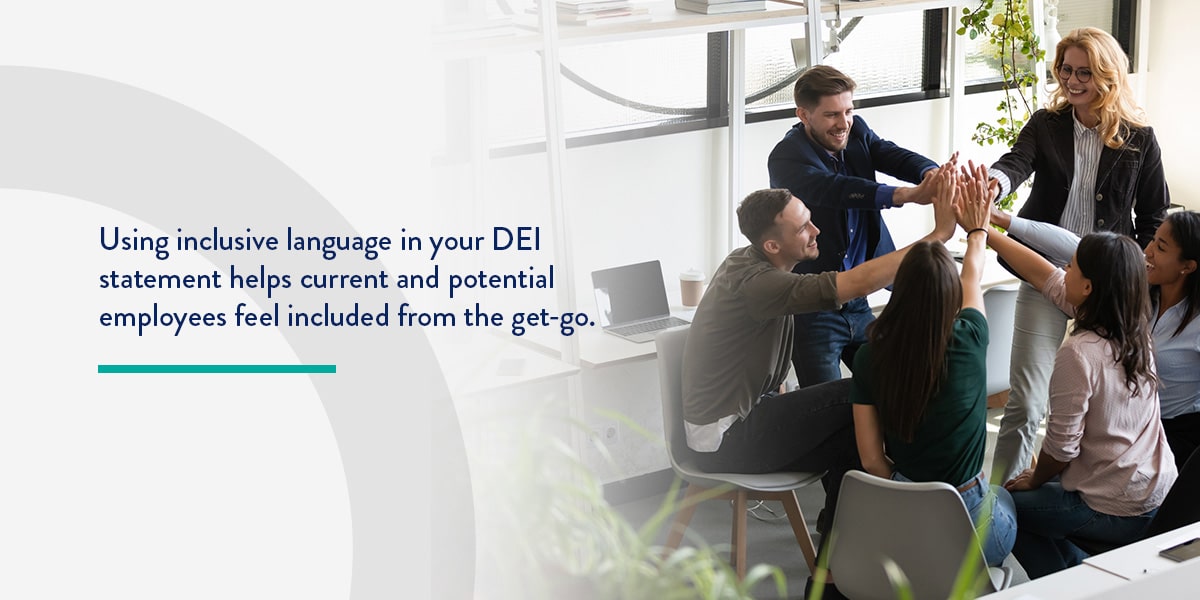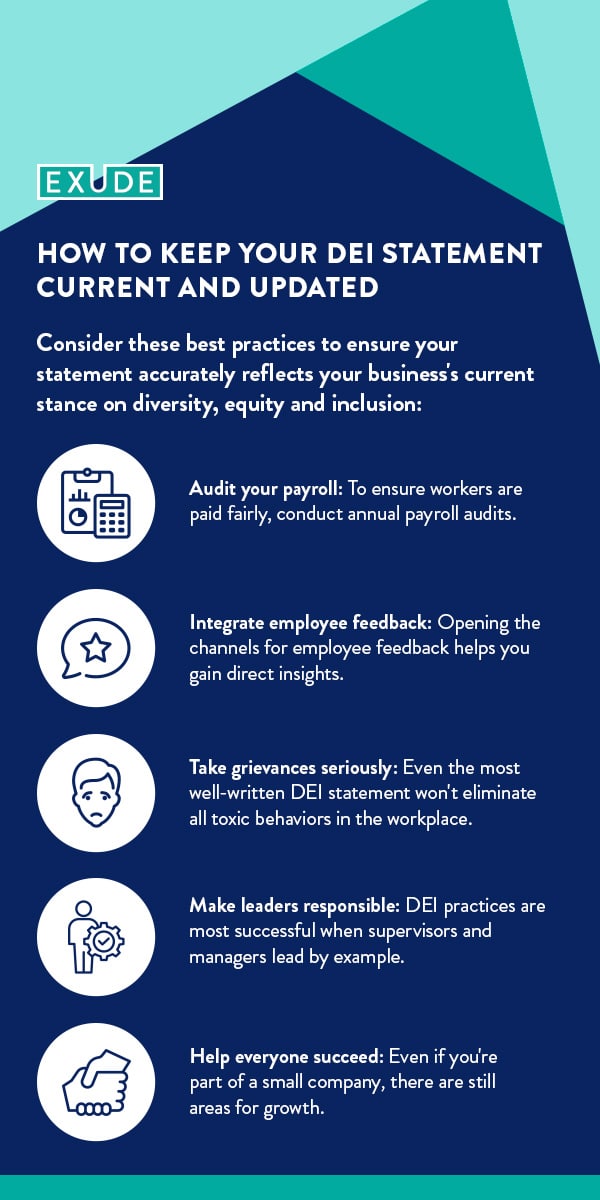DEI
How to Write a DEI Statement

A diverse workforce creates the foundation for increased innovation, productivity and employee wellness — all qualities that contribute to a successful business. One of the most effective ways for HR professionals or C-suite executives to inspire these attributes is to write a powerful DEI statement.
A DEI statement — or diversity, equity and inclusion statement — recognizes the importance of these aspects while paving a path to achieve them. Our guide will answer all of your questions regarding DEI statements, giving you the tools you need to effectively articulate your company’s stance on diversity, equity and inclusion.
Introduction to DEI Statements
Company DEI statements exist to affirm your organization’s dedication to embracing diversity, supporting inclusion and ensuring equitable opportunities. In crafting your DEI statement, you will need to set specific goals and substantiate how you plan to achieve them.
From construction to agriculture to healthcare, every industry benefits from writing a DEI statement. Companies with engaging DEI vision statements stand out in the eyes of employees, partners, investors and customers.
Before you write a DEI statement, it’s important to define what diversity, equity and inclusion mean to your company. Here are the basic definitions of each term to guide your statement:
- Diversity: In the workplace, diversity refers to the external or internal characteristics that make people different. It includes aspects such as language, gender, age, sexual orientation, disability and more.
- Equity: Giving staff equal access to pay, working conditions and career growth opportunities based on their specific attributes is considered “equity.” To maintain equitable access, you need to acknowledge that certain people may have had unequal access to opportunities in the past.
- Inclusion: Businesses that support inclusion provide an environment in which employees can grow and contribute — regardless of their differences. Inclusive workplaces lay a foundation for increased engagement.
The Importance of DEI in Today’s Workplace
By showcasing your commitment to supporting a diverse workforce and ensuring equitable pay, you attract top talent. You are also more likely to retain current employees, reducing turnover costs. Other benefits of embracing DEI in your workplace include:

- Motivated teams: Workers who feel included are more inclined to work toward collective goals. Enthusiastic employees will often get the job done quicker and to a higher standard.
- Healthy work culture: Ensuring DEI in the workplace helps foster higher acceptance levels among workers. A culture of acceptance limits instances of workplace bullying and social exclusion.
- Improved problem-solving: When employees are acknowledged, they are more likely to share opinions and insights. By discussing ideas freely, teams can arrive at solutions faster.
DEI Statement Essentials
As you approach writing your DEI statement, you’ll want to consider a few essential points that should be part of it. Here’s a brief breakdown of what to include:
- Outline your mission: Your company’s mission sets the tone for all company policies. Use your mission as an anchor when writing your DEI statement and showcase how your values support diversity, equity and inclusion.
- Recognize marginalized groups: The first step to supporting underrepresented groups is identifying who they are. Consider the people within the company and the community you operate in when identifying marginalized groups.
- Showcase your initiatives: It’s all very well to manifest a more diverse, inclusive and equitable workplace — but you also need to walk the walk. Detail your current and future initiatives that support your goals.
- Divide information into sections: Even though a DEI statement is relatively short, it is more digestible when structured into sections. Dedicate the first section to indicating your stance on DEI and then explain the steps you will take to achieve it.
- Use simplistic language: At its very core, a DEI statement sets a foundation for inclusivity — ensure you carry that into your statement by using uncomplicated language and short sentences so everyone can clearly understand the information.
- Be positive: A DEI statement reflects your company’s long-term goals for diversity, equity and inclusion. Highlight solutions and use positive language to inspire people to work toward these goals.
How to Craft a DEI Statement
While it’s important to adjust your DEI statement to your organization, there are some standard elements that all companies should include. Consider the following points before putting pen to paper.
1. Assess Your Current DEI Efforts
Whether you’re updating your DEI statement or creating one for the first time, your business likely already has some DEI processes in place. To provide a starting point for your statement, list how your company supports diversity, inclusion and equity.
In evaluating your company, it’s also important to indicate any challenges you may face. It can be helpful to ask yourself questions such as:
- Who constitutes marginalized groups in your organization?
- How can you support them?
- Who is instrumental in driving positive change?
2. Enlist the Help of Stakeholders
The main goal of a DEI statement is to promote inclusion, so involve members from various groups and levels in your organization at the onset. Consider establishing a committee to ensure equal representation.
By facilitating discussions with your committee, you can note different perspectives that will shape your DEI statement. In addition, it’s important for various stakeholders — staff, partners and clients — to have an opportunity to review the finished DEI statement before it goes public.
3. Speak From the Heart
Instead of relying on buzzwords and jargon, celebrate diversity by using sincere, thoughtful language in your statement. Setting realistic, well-communicated goals for diversity, equity and inclusion will indicate your genuine desire to achieve them.

“Inclusive language” refers to words and phrases that are free from discrimination and bias. Using inclusive language in your DEI statement helps current and potential employees feel included from the get-go. Use these tips to ensure your statement speaks to everyone:
- Use gender-neutral pronouns such as “they” instead of “he” or “she.”
- Provide a clear explanation of company acronyms.
- Use people-first language. For example, you might say “workers with disabilities” rather than “disabled workers.”
- Avoid using words related to race or ethnicity. For example, instead of using terms like “blacklist” or “whitelist,” use alternatives like “exclusion list” or “permitted list.”
Additionally, keep in mind that there are bound to be some challenges to achieving inclusion in your workplace. Rather than ignoring them or keeping them private, address them openly. Being transparent about potential obstacles indicates you’re aware of them and are working on strategies to overcome them.
4. Be Accountable
Once you create and publish your DEI statement, you will need to back your claims with actions. Assigning people in your organization to carry out specific tasks helps to share the responsibility and get things done.
Set timeframes for DEI goals and schedule periodic meetings for committee members to showcase their progress. It’s important to decide how you will monitor progress — whether it be in the form of reports, surveys or external reviews.
5. Support Your Goals With Training
Cultural bias is often caused by a lack of knowledge. Ensure your team is on the same page by offering training opportunities that support soft skills such as communication, empathy and adaptivity. In addition, hosting team-building events will help your staff connect and get to know each other better.
From administrative staff to talent acquisition, all members of your organization should receive regular training to continually promote your DEI goals.
6. Integrate Your DEI Statement Into Correspondence
A DEI statement is not just a box-ticking exercise — it’s instrumental to your business’s long-term success. Ensure you carry out your DEI practices by showcasing them in your internal and external correspondence. For example, if you’re advertising a new position, communicate your stance on DEI clearly. Similarly, creating awareness for internal promotions will help you showcase your genuine commitment to equity in the workplace.
7. Monitor Your Progress
While the intent behind any DEI statement is to implement DEI in the workplace, it often takes work to get to that point. Set review dates to assess whether your organization is successful in supporting a diverse, equitable and inclusive environment. Look out for areas of improvement so you can make them a priority. In addition to the review methods you have selected, seek out feedback from leaders and other staff members to get a more accurate idea of your company’s progress.
DEI Statement Examples From Global Companies
Instead of writing a generic DEI statement, look for ways to make it meaningful to your organization. For example, you could include references to your business objectives to make it unique. Some companies that have done this successfully are:
- Spotify: The digital music service weaves in a music reference in its DEI to showcase its commitment to accepting people with diverse backgrounds.
- LEGO Group: The Danish toy production company centers its DEI statement around inspiring the builders of tomorrow — a clever link to the products they manufacture.
- Adidas: The sportswear giant has built its legacy on creating sports apparel for all types of athletes. Adidas echos its commitment to equity by highlighting its willingness to level the playing field so everyone can perform at their best.
How to Keep Your DEI Statement Current and Updated
From the people you hire to the customers you serve, your organization is always changing, and your DEI statement needs to evolve with it. Consider these best practices to ensure your statement accurately reflects your business’s current stance on diversity, equity and inclusion:

- Audit your payroll: To ensure workers are paid fairly, conduct annual payroll audits. In your review, consider how long an employee has been with the company, their job classification and their demographic information, such as gender, race and age.
- Integrate employee feedback: Opening the channels for employee feedback helps you gain direct insights. Use these findings to tweak and refine your DEI statement over time.
- Take grievances seriously: Even the most well-written DEI statement won’t eliminate all toxic behaviors in the workplace. Give staff members a simple, confidential way to bring workplace concerns to the right people. When employees address incidents, react to them appropriately and use these findings to rework your existing statement.
- Make leaders responsible: DEI practices are most successful when supervisors and managers lead by example. Ensure your entire company is focused on implementing the DEI statement, and as new people join the team, get them on board with training.
- Help everyone succeed: Even if you’re part of a small company, there are still areas for growth. Supervisors and managers should meet with new and existing employees to discuss their career goals and use these insights to define paths for career progression. Consider how your DEI statement contributes to success in this regard.
Tips for Incorporating DEI Into Recruitment
Integrating your DEI statement into your hiring process offers many benefits, such as enhanced creativity, problem-solving and engagement. It’s also advantageous to your company’s brand image. Here are some ways to implement your organization’s DEI goals into your recruiting process:
- Job ads and descriptions: By including gender-neutral language in your DEI hiring statement, you ensure all applicants feel welcome to apply for the position. As a result, you get a stronger, more diverse talent pool to consider.
- Interview panels: Including staff of all genders and races in interview panels increases the chance of asking more diverse, well-rounded questions. In addition, candidates may feel more at ease in joining a company that prioritizes sufficient representation.
- Ongoing training: No matter how objective a person intends to be, unconscious bias can still occur. Regular training helps your hiring team be more mindful of these instances and create criteria that limit subjective assessments.
- Job fairs: By showcasing your business at job fairs, you can demonstrate your commitment to DEI while meeting candidates from a diverse range of backgrounds. It’s a win-win situation.
- HR performance: Just as you should encourage current employees to provide feedback on your DEI efforts, you should consider the opinions of potential candidates. After a candidate completes an interview, consider sending them a feedback form to see what they thought of the experience. With that information in mind, you can continue refining the process.
Exude Human Capital Can Help You Build a Better DEI Strategy
In the modern work era, creating a workplace that supports diversity, equity and inclusion is crucial, and it often starts with an effective DEI statement. By taking the time to write a meaningful DEI statement, you encourage better team collaboration, contribute to a positive work environment and so much more. All of that leads to a more successful organization.
These tips and best practices will help you create a more effective DEI statement, but knowing where to start can still be challenging. The team at Exude Human Capital offers professional DEI strategy development and implementation to help you inspire positive change among your team. With our expertise and support, you can build a diverse, inclusive workforce that outperforms the competition.
Reach out to us today to get started!








